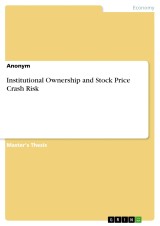Details

Institutional Ownership and Stock Price Crash Risk
1. Auflage
|
18,99 € |
|
| Verlag: | Grin Verlag |
| Format: | |
| Veröffentl.: | 19.07.2024 |
| ISBN/EAN: | 9783389050422 |
| Sprache: | englisch |
| Anzahl Seiten: | 46 |
Dieses eBook erhalten Sie ohne Kopierschutz.
Beschreibungen
Master's Thesis from the year 2024 in the subject Business economics - Investment and Finance, grade: 1,7, University of Hamburg, language: English, abstract: This study uses OLS regressions to analyze the impact of institutional ownership (IO) investment horizons on stock price synchronicity and crash risk for a sample of U.S. companies. Two main hypotheses are tested:
(1) long-term (short-term) IO (LTIO) (STIO) are negatively (positively) related to stock price synchronicity, and
(2) long-term (short-term) IO are negatively (positively) related stock price crash risk.
Stock price synchronicity (SYNCH) measures how much firm-specific returns align with overall market returns, while crash risk (NCSKEW, DUVOL, COUNT) indicates the likelihood of a sudden, significant price drop. The theory posits that short-term investors, more prone to sell shares, provide weaker oversight, giving managers more freedom to influence cash flows and increasing synchronicity. In contrast, long-term investors establish stronger management relationships, reducing synchronicity through enhanced oversight.
The findings reveal that both long-term and short-term IO positively impact synchronicity, contradicting the hypothesis for long-term IO. This aligns with literature suggesting institutional investors use superior information mainly for trading rather than management engagement.
For crash risk, results support the agency theory: long-term IO is associated with reduced crash risk due to better monitoring, while short-term IO correlates with higher crash risk due to frequent trading and weaker oversight. These findings align with prior research, indicating that bad news is disclosed under long-term monitoring, causing abrupt price drops.
During the 2008 financial crisis, average crash risk was significantly higher, especially for financial firms. The interaction between IO horizons and the crisis suggests complex dynamics needing further study, particularly the negative interaction of long-term and aggregated IO during recessions.
Robustness checks, including firm fixed-effects regressions and variable changes, confirm primary findings but suggest cautious interpretation for long-term IO results. Limitations include a relatively short observation period (2000-2017), potential measurement biases in tax avoidance proxies (long-run cash effective tax rate (LRETR)), and unaddressed endogeneity concerns.
Future research should explore evolving ownership structures, corporate social responsibility, and impacts of recent disruptions like the COVID-19 pandemic on crash risk.
(1) long-term (short-term) IO (LTIO) (STIO) are negatively (positively) related to stock price synchronicity, and
(2) long-term (short-term) IO are negatively (positively) related stock price crash risk.
Stock price synchronicity (SYNCH) measures how much firm-specific returns align with overall market returns, while crash risk (NCSKEW, DUVOL, COUNT) indicates the likelihood of a sudden, significant price drop. The theory posits that short-term investors, more prone to sell shares, provide weaker oversight, giving managers more freedom to influence cash flows and increasing synchronicity. In contrast, long-term investors establish stronger management relationships, reducing synchronicity through enhanced oversight.
The findings reveal that both long-term and short-term IO positively impact synchronicity, contradicting the hypothesis for long-term IO. This aligns with literature suggesting institutional investors use superior information mainly for trading rather than management engagement.
For crash risk, results support the agency theory: long-term IO is associated with reduced crash risk due to better monitoring, while short-term IO correlates with higher crash risk due to frequent trading and weaker oversight. These findings align with prior research, indicating that bad news is disclosed under long-term monitoring, causing abrupt price drops.
During the 2008 financial crisis, average crash risk was significantly higher, especially for financial firms. The interaction between IO horizons and the crisis suggests complex dynamics needing further study, particularly the negative interaction of long-term and aggregated IO during recessions.
Robustness checks, including firm fixed-effects regressions and variable changes, confirm primary findings but suggest cautious interpretation for long-term IO results. Limitations include a relatively short observation period (2000-2017), potential measurement biases in tax avoidance proxies (long-run cash effective tax rate (LRETR)), and unaddressed endogeneity concerns.
Future research should explore evolving ownership structures, corporate social responsibility, and impacts of recent disruptions like the COVID-19 pandemic on crash risk.
Diese Produkte könnten Sie auch interessieren:

Bitcoin. Virtuelles Zahlungsmittel oder attraktive Investitionsmöglichkeit?
von: Onur Sunat
Preis: 16,99 €
-
-
© 2024 media control GmbH
Alle Preise enthalten die gesetzliche Mehrwertsteuer. - AGB
- Impressum
- Datenschutzerklärung
- Kontakt
- FAQ
- Mein Konto
- Home
- Erweiterte Suche
- Widerrufsrecht
- Reader-Software
- Desktop-Ansicht
- Gutschein-Code einlösen

